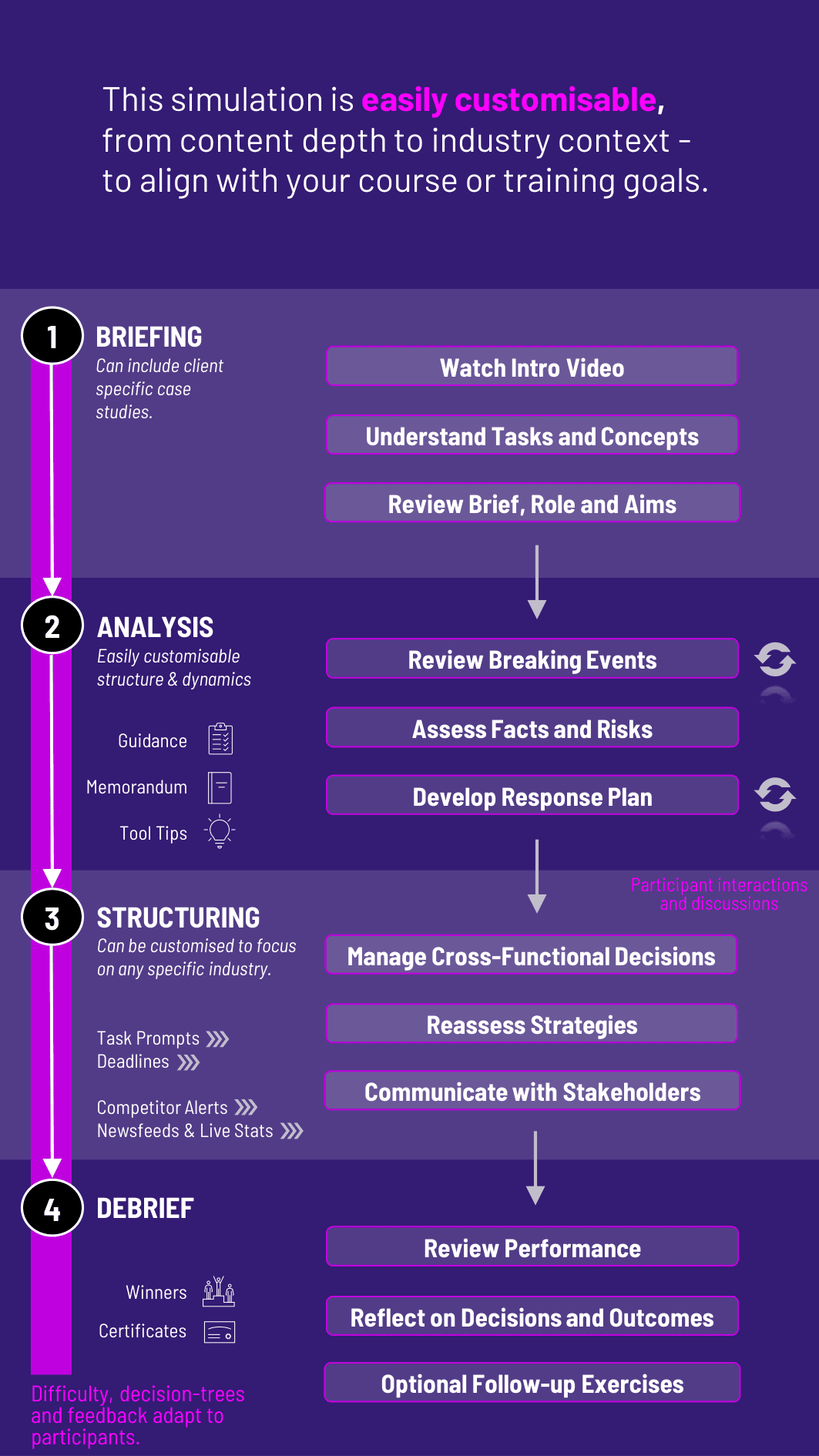
In this high-stakes Crisis Management Training, participants lead decision-making during reputational, financial, and operational crises. They must assess risk, align stakeholders, and communicate clearly - all under intense time pressure.
Crisis Identification & Response Planning
Stakeholder Prioritisation: Internal teams, regulators, media, customers, shareholders
Communication Strategy: Tone, timing, transparency
Financial & Legal Risk: Containment and regulatory implications
Cross-Functional Alignment: Coordinating finance, ops, HR, and legal
Media and Reputation Management: Handling public fallout
Post-Crisis Review: Root cause analysis and long-term rebuilding
Scenario Planning & Resilience Building


Receive a breaking event and review real-time updates
Assess the facts, risks, and unknowns across business functions
Develop and execute response plans under time pressure
Communicate with stakeholders - customers, board, regulators, media
Manage cross-functional decision-making with limited information
Reassess strategies as new developments emerge
Reflect on what worked, what failed, and how future resilience can be built
Crises may include cybersecurity breaches, PR disasters, product recalls, leadership misconduct, financial distress, or activist interventions.
By the end of the training, participants will be more confident in:
Leading under uncertainty and pressure
Making fast, high-impact decisions with limited data
Communicating clearly and confidently in tense situations
Balancing competing interests and time-sensitive risks
Managing internal alignment and coordination in chaotic environments
Thinking strategically during short-term volatility
Applying structured thinking to unpredictable scenarios
Handling reputational risk and stakeholder trust
Learning from crisis to build long-term institutional resilience
This is especially powerful for future managers, business leaders, and professionals in high-responsibility roles. The training’s flexible structure ensures that these objectives can be calibrated to match the depth, duration, and focus areas of each program.
1. Receive a Crisis Scenario Participants receive a realistic crisis trigger (e.g. data breach, fraud report, viral complaint), plus key facts and context.
2. Assess and Prioritise They identify the critical stakeholders, immediate risks, legal considerations, and communication needs.
3. Make Time-Sensitive Decisions Participants must respond across communication, operations, finance, HR, and legal - often with incomplete information.
4. Monitor Response Impact Outcomes evolve based on decisions made - affecting public reaction, financial health, team morale, and compliance exposure.
5. Debrief and Reflect After each round, participants analyze outcomes, review blind spots, and adapt their response plans for the next round.
6. Iterate with New Challenges Multiple trainings can be run - ranging from internal failures to external shocks - to test agility, leadership, and resilience thinking.
Do participants need crisis experience? No. The training is suitable for learners with basic business knowledge and can be scaled in difficulty.
What types of crises are simulated? Cyberattacks, PR fallout, product failures, executive misconduct, market shocks, and more.
Is the training quantitative or qualitative? Primarily qualitative - focused on strategic decision-making, communication, and judgment under pressure.
Can we customise the crisis scenarios? Yes. Scenarios can be tailored by industry, region, or specific business functions.
Is it individual or team-based? It can be run as either. Team-based runs mirror real cross-functional crisis response groups.
How is performance measured? By decision quality, stakeholder impact, response timing, communication clarity, and overall resilience shown.
Can it be used in leadership or executive education? Yes. It is well-suited for both early-career professionals and senior leaders.
Are real-time updates included? Yes. The training includes dynamic developments and new inputs across each round to simulate uncertainty.
How long does the training run? From 2 hours (single crisis) to multi-session formats (series of escalating challenges).
Is debriefing included? Yes. Facilitator-led debriefs can focus on team dynamics, blind spots, and what would be done differently.
Decision speed and strategic judgment
Communication under stress
Stakeholder sensitivity and alignment
Ethical reasoning and regulatory awareness
Post-crisis reflection and learning
Team collaboration and leadership presence
Overall business resilience strategy
You can also include memo writing and debrief presentations as part of the assessment structure. Additionally, you can also add a built-in peer and self-assessment tool to see how participants rate themselves. This flexibility allows the training to be easily integrated by HR at assessment centres at companies.
Join this 20-minute webinar, followed by a Q&A session, to immerse yourself in the training.
or
Book a 15-minute Zoom demo with one of our experts to explore how the training can benefit you.